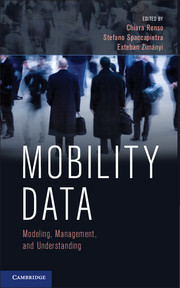Book contents
- Frontmatter
- Contents
- List of Contributors
- Preface
- Acknowledgments
- PART I MOBILITY DATA MODELING AND REPRESENTATION
- PART II MOBILITY DATA UNDERSTANDING
- 6 Mobility Data Mining
- 7 Understanding Human Mobility Using Mobility Data Mining
- 8 Visual Analytics of Movement: A Rich Palette of Techniques to Enable Understanding
- 9 Mobility Data and Privacy
- PART III MOBILITY APPLICATIONS
- PART IV FUTURE CHALLENGES AND CONCLUSIONS
- Bibliography
- Glossary
- Author Index
- Subject Index
- Plate section
6 - Mobility Data Mining
from PART II - MOBILITY DATA UNDERSTANDING
Published online by Cambridge University Press: 05 October 2013
- Frontmatter
- Contents
- List of Contributors
- Preface
- Acknowledgments
- PART I MOBILITY DATA MODELING AND REPRESENTATION
- PART II MOBILITY DATA UNDERSTANDING
- 6 Mobility Data Mining
- 7 Understanding Human Mobility Using Mobility Data Mining
- 8 Visual Analytics of Movement: A Rich Palette of Techniques to Enable Understanding
- 9 Mobility Data and Privacy
- PART III MOBILITY APPLICATIONS
- PART IV FUTURE CHALLENGES AND CONCLUSIONS
- Bibliography
- Glossary
- Author Index
- Subject Index
- Plate section
Summary
Introduction
What Is Mobility Data Mining?
The trajectories of a moving object are a powerful summary of its activity related to mobility. As seen in Chapters 3 and 4, such information can be queried in order to retrieve those trajectories (and the objects that own them) that respond to some given search criteria, for instance following a predefined interesting behavior. However, when massive amounts of information are available, we might be able to move a step further and ask that such “interesting behaviors” automatically emerge from the data. That is precisely the domain explored by mobility data mining.
Moving from queries to data mining essentially consists of adding degrees of freedom to the search process that the algorithms perform. For instance, a query might consist of searching those trajectories that at some point perform the following sequence of maneuvers: abrupt slow down, U-turn, and, finally, accelerate. One possible corresponding data mining task, instead, might require one to discover which sequences of maneuvers are performed frequently in the database of trajectories. Then, the output sequences obtained might also contain the slow down → U-turn → accelerate example just mentioned. To perform this data mining process the user needs to specify the general structure of the behaviors he or she searches (sequences), what kind of elements they can contain (the set of maneuvers to consider, as well as a precise way to locate a given maneuver within a trajectory), and a criterion to select “interesting” behaviors – in our example, the user wants only behaviors that appear frequently in the data.
- Type
- Chapter
- Information
- Mobility DataModeling, Management, and Understanding, pp. 105 - 126Publisher: Cambridge University PressPrint publication year: 2013
- 1
- Cited by

